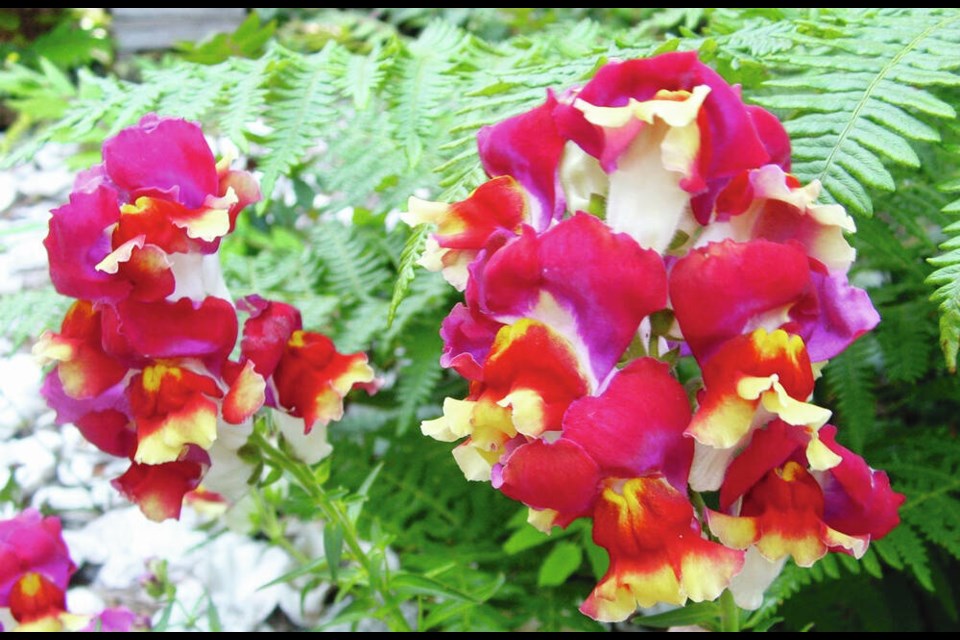With one notable exception, the conditions over the past weeks were fairly gentle, with more useable outdoor days than the month usually brings.
I found the days passed with almost shocking speed, delivering periods of needed rain and several days of warm sunshine alternating with spells of icy winds. Then there was that bombshell of a storm in the third week. Nasty. Even in our pleasant Island home, we’re not immune to tempestuous weather.
Snapping jaws and childhood play. I’ve been wondering for a long time why more gardeners don’t plant snapdragons. They are so beautiful, and easy to grow. And though they are grown as annuals, the plants are actually tender, short-lived perennials.
Over a decade ago I began to notice snapdragon plants surviving the winter to grow and bloom again. It’s been a common occurrence since then. In spring, I clip off untidy and dried top growth and leave the plant to re-green and bloom.
In my garden, snapdragon plants last for a few growing seasons before becoming woody, and no longer worth keeping. Only then do I pull them up.
Meanwhile, self-sown snapdragon seedlings can be counted upon to pop up here and there in the landscape — floral “freebies.”
Some of us will have sweet memories of incorporating flowers into our childhood playtime. I recall biting off the ends of the “tails” at the back of nasturtium flowers and sucking out the sweet liquid. That “tail” is a funnel-shaped nectar spur.
Snapdragons were fun. We played “dragons” with the two-lipped blooms. We would hold a bloom at its sides, from the back, and squeeze gently to “snap” open the flower, forming in our imaginations a dragon’s mouth.
The two-part, snapping type remains the traditional, classic snapdragon form. Another type with open-faced, full and fluffy blooms is also lovely. They are referred to as butterfly or azalea-flowered snapdragons. The Madame Butterfly series is an example.
These tough, showy flowers come in a broad range of heights. The smallest, like Floral Showers, are just 15 to 20 cm high. I used to plant dwarf snapdragons in bowl-shaped planters placed on a rock ledge alongside the path into the back garden. At the other end of the height scale are majestic cut flower varieties such as the Rocket series at 100 cm and the Potomacs at up to 150 cm. Many varieties grow to medium heights.
Growing snapdragons. Over many years of growing snapdragon plants from seed, I’ve found them among the easiest flowers to grow. I find it endearing that such easy, beautiful, free-flowering plants are also tough. I’ve had some self-sow into a rock platform where potted snapdragons had been placed the previous year. Growing out of rock, the plants flourished and blossomed prolifically.
I start snapdragon seeds early, usually mid-January to mid-February, sowing the tiny seeds on top of a dampened, lightweight mix. Because light promotes good germination, I either press the seeds gently onto the soil or sprinkle only a scant layer of the mix on the seeds before lightly firming it down and placing the seeded flat in bright indirect light, covered loosely with clear plastic. The seeds germinate in seven to 14 days.
Transplants are commonly available in the spring. Growing from seed expands choices to unusual varieties. Some local seed racks will be a source. Johnny’s Selected Seeds in Maine specializes in cut flowers and lists an extensive range of varieties. William Dam Seeds is another good source.
Though their new seed list is not yet available, the 2024 Lindenberg Seeds catalogue has a wonderful selection of snapdragon varieties, at the lowest prices I’ve seen. The catalogue lists Twinny Peach, one of my favourites. Their print catalogue can be ordered at lindenbergseeds.ca — in January for the 2025 edition.
GARDEN EVENT
Mixing it Up 2025. The Victoria Master Gardeners are hosting their biennial Mixing it Up Conference on Saturday, February 1, 2025, at the Mary Winspear Centre in Sidney. The theme is “Beyond Beauty.” The conference will include five speakers who will share how adding biodiversity creates healthy and beautiful gardens. Topics include urban trees, designing with native plants, citizen science in the garden, and “Mind What You Sow.” For more information on the talks and the speakers, and to register, please go to mixingitup.org or mgabc.org.



